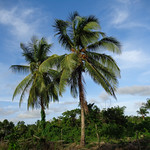
Fire managers can benefit significantly from enhanced weather predictions based on warm air masses near boreal areas in southernmost Siberia, where wildfires release high levels of carbon and methane from the thawing permafrost, according to scientists.
Active blazes in the lower Amur River basin of the Khabarovsk region, which is prone to wildfire activity, can be forecast several days in advance by following warm air movements based on daily temperature maps. Since most hotspot peak days occurred when the wind velocity exceeded 30 kilometers per hour, weather forecasters could issue a high-wind warning in order to help prevent active wildland fires.
These are among the findings of a study funded by the government of Japan under the joint research program with the Center for International Forestry Research (CIFOR) and Khabarovsk Federal Research Center, with support from the Hokkaido University Arctic Research Center.
Global warming in the Arctic has accelerated the thaw rate of the region’s permafrost, whose soil holds twice as much carbon as the amount of CO2 in the atmosphere. Over the past two decades, carbon release from thawing permafrost has been caused by boreal wildland fires, which can create thermokarst depressions and threaten boreal ecosystems.
Southernmost Siberia is home to dense boreal forests and peatlands in the permafrost zone, where devastating forest fires have occurred over past decades, notably the Black Dragon Fire of 1987, one of the largest conflagrations of its kind in several centuries.
While more than 87 percent of boreal forest fires in Russia are caused by human activities – such as land reclamation, logging, camping and hunting – more fires have taken place in years when weather patterns showed anomalies that could have contributed to improved forecasts.
Previous research on spring fires in southeastern Siberia has focused mainly on monthly data. The scientists in this latest study therefore aimed for a more accurate description of weather conditions by conducting a daily analysis of hotspot data provided by the MODIS imaging instrument on NASA’s Terra and Aqua satellites from 2003 to 2019.
Using weather charts, temperature maps and wind maps, they identified four active fire periods – occurring in April, May, July and October – and found that strong winds from low-pressure systems or meandering westerlies played a key role. Summer fire forecasts in July will be possible with the help of a temperature map to monitor the movement of a warm air mass that moves from the southwest, according to the scientists.
“The number of forest fires in the Khabarovsk boreal region has been rising despite fire information campaigns, local preventive work and new fire-detection technologies,” says Hiroshi Hayasaka, a researcher at Hokkaido University’s Arctic Research Center in Japan and the study’s lead author. “This suggests that a more effective fire forecasting system is needed to reduce the risk of active forest blazes in the area.”
The study attempted to build on a previous research project funded by the Global Environment Facility and implemented by the World Bank. Its aim was to strengthen the conservation of forests with high biodiversity value in the Amur–Sikhote–Alin ecoregion by improving its fire management, the authors wrote.
The Khabarovsk region has a unique boreal ecosystem and its taiga forest is among the most biologically diverse in Russia. The river basin is home to 130 fish species, 200 mammal species, at least 600 bird species, and about 6,000 species of vascular plants. It is one of the world’s 200 most valuable wilderness places, according to the World Wildlife Fund’s Global 200 Study.
“The increased frequency of forest fires accompanied by human behavior has had a significant impact on this region, which was settled by Indigenous and minority groups long before the Russian people arrived,” says Galina V. Sokolova, a researcher at the Khabarovsk Federal Research Center and a co-author of the study.
“Improved fire forecasts can contribute to the conservation of the diverse flora and fauna in these boreal forests, while protecting the traditional hunting and fishing cultures that have existed for centuries.”
We want you to share Forests News content, which is licensed under Creative Commons Attribution-NonCommercial-ShareAlike 4.0 International (CC BY-NC-SA 4.0). This means you are free to redistribute our material for non-commercial purposes. All we ask is that you give Forests News appropriate credit and link to the original Forests News content, indicate if changes were made, and distribute your contributions under the same Creative Commons license. You must notify Forests News if you repost, reprint or reuse our materials by contacting forestsnews@cifor-icraf.org.












